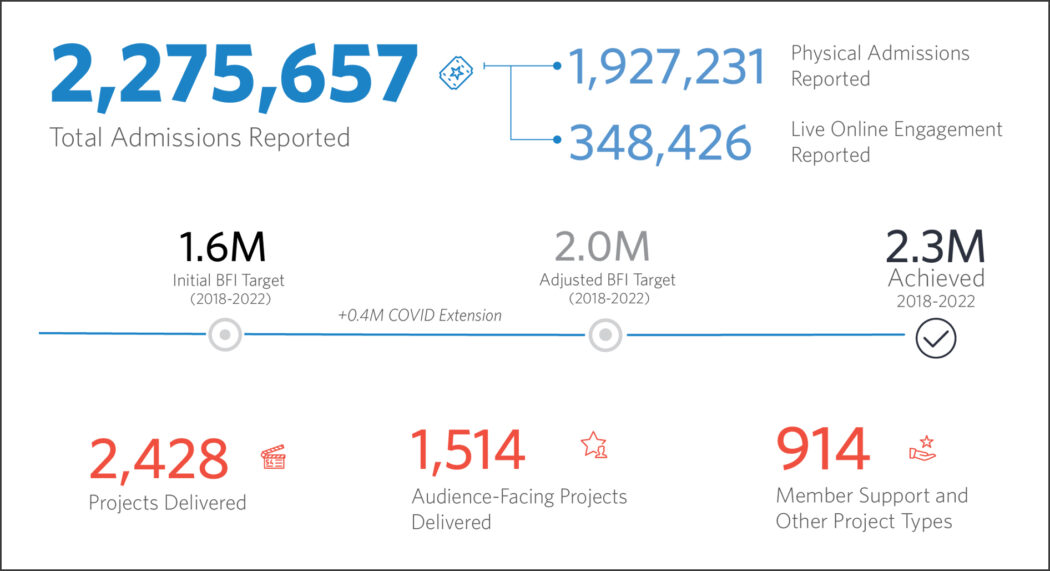In early 2023, Film Hub South East (as run by the Independent Cinema Office), using National Lottery funding from the British Film Institute, commissioned Indigo-Ltd to conduct an evaluation of the BFI Film Audience Network (FAN) for the period January 2018 – December 2022.
On this page you can find some topline details about the findings of the evaluation, but Indigo-Ltd’s full report can be downloaded on the button below.
Findings & conclusions
Overall outcomes
- The FAN model and approach was viewed very positively overall by Hubs and members. It was seen as a unique model of funding and support, and it provides an exemplary template for collaboration and localised provision. The combination of targeted funding – sometimes only small amounts – and collaborative, supportive working relationships created meaningful projects embedded in communities and catalysed partnership working to develop a more connected sector.
- Over £8m grants were distributed to 2,428 projects, of which 1,514 were audience-facing projects (those that directly targeted the public and recorded admissions, in person or online).
- The gross value added by FAN activity was estimated to be at least £21.2m. This was a conservative estimate due to a lack of adequate data on audience spend and additionality.
- Across all FAN projects, the median average ‘cost per head’ (grant spent for each attendance) figure was £5.19. The typical range of ‘cost per head’ (CPH) within the FAN programme was between £2.83 – £11.03. This means that each physical attendee for a project that was supported by a FAN grant, cost between £2.83 and £11.03.
Audience outcomes
- FAN exceeded its original 1.6m target admissions, with nearly 2.3m admissions, of which 1.9m were physical and 0.3m live online. Live online screenings were a new development as organisations responded to the enforced closures of the pandemic lockdown. Even with a pro rata adjustment of the original target to include the additional 2022/23 year (which would equate to a target of 2m admissions), FAN achieved the aim of developing a larger audience for independent film.
- Year-on-year physical admissions totals had been falling pre-Covid and were then hit by the Covid-19 pandemic and lockdowns. Whilst they have begun to recover, 2021/22 admissions remained at 63% of 2019/20 admissions.
- Targets for audience development were exceeded for Under 30s and LGBTQIA+ audiences but fell slightly short for both ethnically diverse and disabled audiences. Where projects were specifically designed to develop an audience, overall these performed strongly, suggesting that focusing funding on projects designed to reach under-served audience segments is a successful approach.
- Increasing access to Screen Heritage – a specific aim for FAN – was achieved on a smaller scale than other project strands, but Screen Heritage projects were successful in terms of median average admissions and played a central role in placemaking within communities. However, younger audiences – a key target for FAN – were under-represented in these projects.
- Performance varied by region due to geo-demographic differences, differences in exhibitor sector structure, challenges in local and regional infrastructure (e.g., transport) and differences in other funding sources. Targets were therefore sometimes too generalised and did not take account of specific intra-regional or intra-national differences.
- Audience experience was overall very positive (100% good or very good ratings on overall experience). Survey questions were not all directly related to the outcome framework.
- Several key themes of success emerged from the evaluation of member activity, which directly contribute to the BFI’s overall aims: building communities, driving collaboration, developing EDI-led organisations, environmental sustainability and placemaking.
Member outcomes
- The FAN structure delivered extremely well on its aims to create a more connected and confident sector. As well as very high satisfaction ratings in the surveys, the benefits of the network in offering accessible support and advice was a strong emerging theme in interviews, and was seen as a unique funding and support structure.
- 740 member support projects were run, achieving almost 10,000 individual contact points with industry professionals from member organisations through bursaries, conferences, training courses and other sector support activity. Recording of these numbers was, however, not consistent across Hubs, limiting comparative analysis.
- There were some challenges with FAN funding structures: single-year funding agreements; the lack of a clear pathway for organisations to transition to national centralised funding sources; and a one-size-fits-all approach which sometimes did not fit their specific work. It is worth noting that some of these challenges have been addressed by changes to funding structures for the next period of FAN.
Recommendations
- Continue to invest in the Film Audience Network, via the system of Film Hub Lead Organisations, to deliver local activity. The programme is effective and achieved most targets, in some cases exceeding them. FAN is a critical lever to deliver Screen Culture 2033, with high impact and value to the UK screen sector in delivering BFI aims.
- Exploit the experience and learnings from FAN activity (including around EDI and Sustainability) for the benefit of the wider UK screen sector, sharing and learning from best practice. FAN’s UK-wide network and collaborative structure provides a proven model for developing localised provision based on identified needs, especially when looking forward through the lens of Screen Culture 2033.
- Continue the successful focus on young audiences, but develop more opportunities for young people to engage with screen heritage. This is under-developed for younger audiences yet has proven success in placemaking and community cohesion.
- Consider increasing investment in projects focusing on ethnically diverse and D/deaf and/or disabled audiences. These audiences did not reach the target over the period (based on the median average), yet there are many examples of excellent outcomes across FAN member activity.
- Multi-year funding opportunities would benefit many member organisations to enable longer-term planning.
- There need to be clearer options for those organisations who have outgrown the limits of FAN funding (in terms of criteria and/or levels of funding required) but do not qualify for the Audience Fund due to not being fully national (eg multi-county organisations). This increased pressure on the FAN funding pot needs to be addressed to ensure that effective organisations do not fall into the gap between FAN and other BFI funding. Where member organisations are developing a national programme, Hubs have a role in signposting to national programmes of funding, mainly the Audience Project Fund. The new R&D strand of this fund should help provide an element of bridging for these organisations as they grow.
- Ensure FHLOs have a clear voice within the BFI to advocate for the reality of what is achievable in delivering audiences and activity on the ground, especially as the shadow of Covid-19 continues to present challenges to organisations in both surviving and developing audiences.
- In evolving outcome frameworks, build in the more intangible or indirect benefits of FAN and FHLOs such as regional advocacy, partnership development and member organisation mentoring and support, ensuring they are adequately funded to deliver these additional benefits.
- When setting audience targets, try to do more to acknowledge the regional differences which impact audience attendance, whether due to different demographics or barriers to attendance (eg transport).





